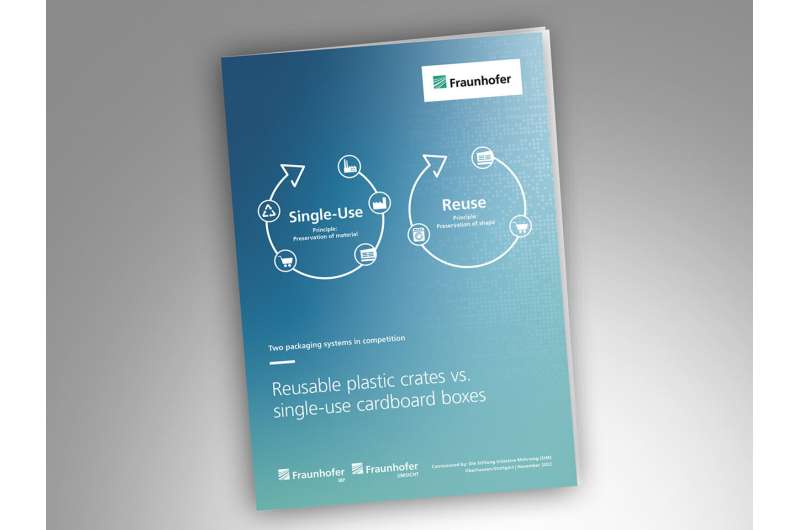Single-use cardboard boxes or reusable plastic crates—which type of packaging is more sustainable?

Plastic or cardboard? Single-use or reusable? The question on which type of packaging is the more sustainable solution is not an easy one to answer.
Among other things, comprehensive life cycle assessments (LCAs) are required that take into account the manufacturing process, transport, use and recycling at the end of the solution's service life. The Fraunhofer institutes involved have already conducted several studies and life cycle assessments on plastic packaging, reusable systems and recycling solutions while also investigating the emissions of plastics into the environment.
The authors wish to provide political and industrial decision-makers with balanced recommendations for action to enable sustainable production and consumption, minimize the use of resources and significantly reduce plastic waste and emissions.
Comparative life cycle assessments require transparent parameters
The researchers' present report concludes that, in most cases, reusable plastic packaging is superior in ecological terms to single-use cardboard packaging. The scientific teams refer to four studies in total, two commissioned by the European Federation of Corrugated Board Manufacturers (FEFCO) and conducted by VTT and Ramboll3, and two studies by Fraunhofer UMSICHT and Fraunhofer IBP commissioned by Stiftung Initiative Mehrweg (SIM), and explain the general challenges and limits of comparative studies on environmental impacts.
Often, the reasons for diverging results produced by comparative LCAs are due to different study parameters, the data used or even modeling approaches.
"We therefore recommend that comparative life cycle assessments must be conducted on the basis of transparent, realistic parameters to be agreed upon in advance in a multi-stakeholder process. Furthermore, civil society—and not just competing associations—should also be involved in the process. It is up to the political players to enable this dialogue," concludes lead author of the study Jürgen Bertling of Fraunhofer UMSICHT.
Promoting reusable systems, strengthening the waste hierarchy
The basic recommendation of the scientist teams for a decision between plastics or cardboard as a packaging material is: The waste hierarchy anchored in Europe (1. Avoidance, 2. Reuse—including repair or cleaning in particular—3. Material Recycling and 4. Thermal Recycling and in the end 5. Disposal) must be maintained, strengthened and also implemented. Deviations from this hierarchy should only be possible if another solution is proven to be more advantageous when all relevant sustainability criteria are considered.
This also comprises littering, product protection or technological sovereignty. This is because single-use packaging, for example, contributes significantly more to littering than reusable packaging. Reusable plastic packaging can protect products in a better way due to a higher material input which can be apportioned to several uses. In addition, they have a higher wet strength. Furthermore, reusable packaging systems reduce the import dependency as they promote regional logistics and transport solutions.
While a high recycling rate is, in principle, good for a circular economy, more of a focus needs to be placed on the reuse rate of secondary material for the same—or at least equivalent—purpose. This is the only way to avoid downcycling—recycled material is only suitable for products that do not have to apply to high quality requirements like e.g. for a palisade—and achieve a true circular economy.
Moreover, the study's authors recommend a transparent monitoring of the central parameters of reusable systems which include circulation figures, breakage and leakage rates, and end-of-life recycling rates in order to enable a fair comparison of the results.
The research was published by the Fraunhofer-Gesellschaft research organization.
More information: Stefan Albrecht et al, Reusable Plastic Crates vs. Single-Use Cardboard Boxes, Fraunhofer-Gesellschaft (2022). DOI: 10.24406/publica-456
Provided by Fraunhofer-Gesellschaft




















